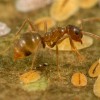 Carpenter ants are in the genus Camponotus, in which up to over 900 species have been described worldwide. They get their common name, “carpenter ant,” because some species excavate nests in wood. Carpenter ants are sometimes called bulldog ants or bull ants. However, not all species in the genus Camponotus are true carpenter ants because some nest in preformed cavities or in soil. This 5-page fact sheet was original published as part of Pests in and around the Florida Home, and was written by R. J. Vazquez, P. G. Koehler, R. M. Pereira, J. Warner, and R. H. Scheffrahn, and published by the UF Department of Entomology and Nematology, October 2013.
Carpenter ants are in the genus Camponotus, in which up to over 900 species have been described worldwide. They get their common name, “carpenter ant,” because some species excavate nests in wood. Carpenter ants are sometimes called bulldog ants or bull ants. However, not all species in the genus Camponotus are true carpenter ants because some nest in preformed cavities or in soil. This 5-page fact sheet was original published as part of Pests in and around the Florida Home, and was written by R. J. Vazquez, P. G. Koehler, R. M. Pereira, J. Warner, and R. H. Scheffrahn, and published by the UF Department of Entomology and Nematology, October 2013.
http://edis.ifas.ufl.edu/in1075
Tag: John Warner
Tawny Crazy Ant (previously known as Caribbean crazy ant) Nylanderia (formerly Paratrechina) fulva (Mayr) (Insecta: Hymenoptera: Formicidae: Formicinae)
 Nylanderia fulva is part of a group of ants referred to as “crazy ants” due to their quick and erratic movements. It has been reported from 27 counties of Florida and 27 counties of Texas, as well as from Louisiana, Mississippi, Alabama and Georgia. Huge number of workers in infested areas can make human activities uncomfortable and difficult. They can infest sidewalks, buildings and gardens, and damage phone lines, air conditioning units and computers. They have killed honey bee larvae and used the hives as their nests, and are even displacing red imported fire ants where the two populations overlap in Texas. This 5-page fact sheet was written by Shweta Sharma, John Warner, and Rudolph H. Scheffrahn, and published by the UF Department of Entomology and Nematology, December 2014. (Photo: Lyle Buss, UF/IFAS)
Nylanderia fulva is part of a group of ants referred to as “crazy ants” due to their quick and erratic movements. It has been reported from 27 counties of Florida and 27 counties of Texas, as well as from Louisiana, Mississippi, Alabama and Georgia. Huge number of workers in infested areas can make human activities uncomfortable and difficult. They can infest sidewalks, buildings and gardens, and damage phone lines, air conditioning units and computers. They have killed honey bee larvae and used the hives as their nests, and are even displacing red imported fire ants where the two populations overlap in Texas. This 5-page fact sheet was written by Shweta Sharma, John Warner, and Rudolph H. Scheffrahn, and published by the UF Department of Entomology and Nematology, December 2014. (Photo: Lyle Buss, UF/IFAS)
http://edis.ifas.ufl.edu/in1071